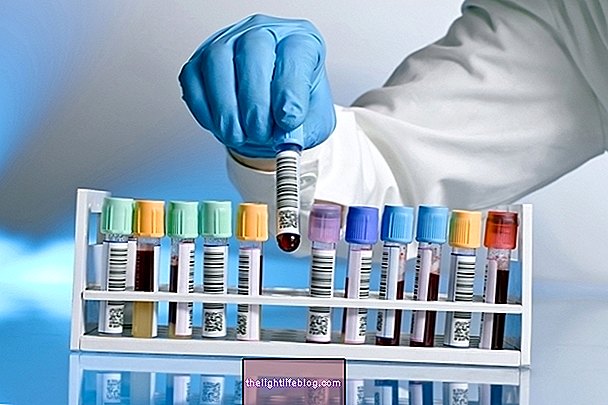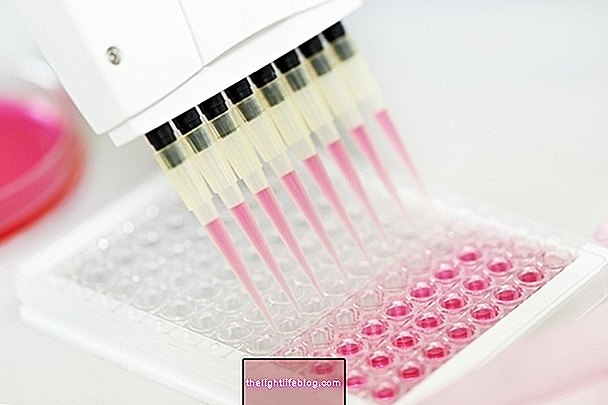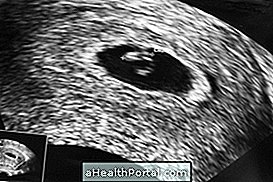D-dimer, also known as D-dimer, is one of the products of fibrin degradation, which is a protein that is involved in the formation of the clot. Thus, when there are changes in the coagulation process, it is possible that there is a greater amount of circulating D-dimer.
The reference value of D-dimer in the blood is up to 0.500 µd / mL or 500 ng / mL, it is important to investigate the cause of increased values of this marker, which can be done through blood tests such as blood count, tests that evaluate the liver and C-reactive protein dosage, for example.

What is it for
The dosage of D-dimer is usually indicated by the doctor in order to rule out the possibility of deep vein thrombosis and pulmonary thromboembolism, since this marker is increased in these situations.
However, since it is a coagulation marker, D-dimer can also be requested with the objective of evaluating the functioning of the coagulation cascade, since after the activation of fibrin to compose the platelet buffer, the pathway of activation is activated. fibrin degradation, leading to the release of degradation products in the blood. However, when there is a change in coagulation, it is possible to see an abnormal amount of fibrin degradation products, including D-dimer. Better understand how coagulation happens.
Thus, in addition to serving to rule out the occurrence of deep venous thrombosis and pulmonary thromboembolism, the measurement of D-dimer can also be useful in investigating situations that can interfere with clotting, such as heart problems and inflammation, for example.
What does increased D-dimer mean
The change in D-dimer levels occurs in situations where there is formation and degradation of clots, resulting in an abnormal increase in blood levels of fibrin degradation products, which is the main component of clots. Thus, the increase in D-dimer levels is mainly related to the increased risk of deep vein thrombosis (DVT) and pulmonary thromboembolism (PTE). However, other situations that can lead to an increase in D-dimer are:
- Disseminated intravascular coagulation;
- After major surgeries;
- Major traumas;
- During the pregnancy;
- Heart, kidney or liver diseases;
- Inflammations;
- Use of anticoagulants;
- Some types of cancer;
- COVID-19 in some cases.
In addition to the evaluation of the D-dimer, it is important that other tests are performed to help identify the cause of the increase in this marker. Thus, according to the person's health history and presence of symptoms, the doctor may recommend the performance of the blood count, tests to assess the function of the liver, kidneys and heart and the dosage of lactate dehydrogenase and C-reactive protein.
Other tests that can be ordered together with the D-dimer are prothrombin time, thrombin time, bleeding time and partial thromboplastin time, which are tests that are part of the coagulogram and that allow to evaluate if the coagulation process is happening normally . Learn more about coagulation tests.
D-dimer and COVID-19
The increase in D-dimer is a common laboratory finding in cases of COVID-19, because in the body's attempt to fight the virus responsible for the disease, a large amount of cytokines is released, which causes damage to the blood vessels and activates the coagulation cascade. Thus, there is activation of a large amount of fibrin and, consequently, of the pathway responsible for degrading this protein, increasing circulating D-dimer levels.
Thus, the increase in the levels of this marker in the blood may be indicative of infection and, depending on the values, may indicate to the physician the severity of the infection, the risk of intravascular coagulation caused by COVID-19 and the need for hospitalization. However, it is also important to assess fibrin levels, platelet count and prothrombin time and the symptoms presented by the person. See more about COVID-19.
Was this information helpful?
Yes No
Your opinion is important! Write here how we can improve our text:
Any questions? Click here to be answered.
Email in which you want to receive a reply:
Check the confirmation email we sent you.
Your name:
Reason for visit:
--- Choose your reason --- DiseaseLive betterHelp another personGain knowledge
Are you a health professional?
NoMedicalPharmaceuticalsNurseNutritionistBiomedicalPhysiotherapistBeauticianOther
Bibliography
- INVITRO. The Role of D-Dimer in COVID-19 Infection. 2020. Available at:. Accessed on 17 Mar 2021
- THACIL, Jecko; CUSHMAN, Mary; SRIVASTAVA, Alok. A proposal for staging COVID-19 coagulopathy. Res. Procr. Thromb Haemost .. 4th ed; 731-736, 2020
- BRAZILIAN SOCIETY OF CLINICAL PATHOLOGY. Laboratory aspects of coagulation - thromboembolic diseases. Available in: . Accessed on 17 Mar 2021
- BRAZILIAN SOCIETY OF CLINICAL ANALYSIS. Laboratory changes in patients with Covid-19. Available in: . Accessed on 17 Mar 2021
- GOUDORIS, Ekaterini S. Laboratory diagnosis of COVID-19. J Pediatr (Rio J). Vol 97. 7-12, 2021
- KANTRILL, Aziza; ZIATI, Jihane; KHALIS, Mohamed et al. Hematological and biochemical abnormalities associated with severe forms of COVID-19: A retrospective single-center study from Morocco. PLOS One. 2021





















.png)